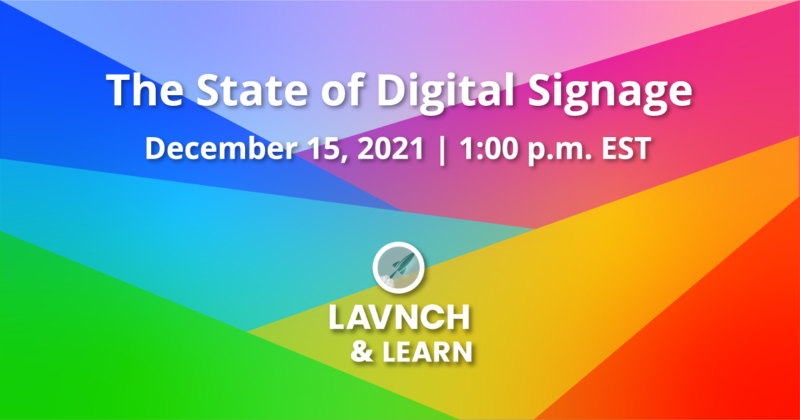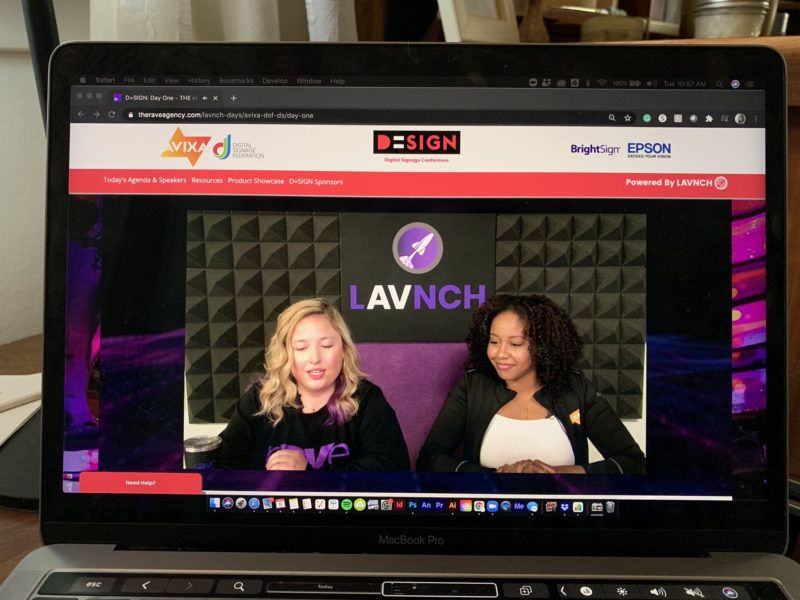SYNNEX VISUALSolv Public Spaces Today: Laura Davis-Taylor and the Safe Place Process

Hello everyone and welcome to your SYNNEX VISUALSolv Public Spaces Today LAVNCH Day wrapup. I’m your host (during the live portion and this written portion), Steph Beckett! This particular SYNNEX VISUALSolv Day taught us a lot about what we can look forward to and what consumers will expect as they enter public spaces in the future.
I want to talk to all of you about the keynote, given by Laura Davis-Taylor of InReality and the Digital Signage Federation. LDT is no stranger to a rAVe LAVNCH Week, and she always has great subject matter to talk about. For this most recent event, her keynote was on “Trends, Spends and Future Forecasts: What’s Now and Next for Public Spaces.”
It’s a fair question. A day doesn’t seem to pass without all of us looking at each other and wondering what we are going to do next. Are retail, hospitality and other public spaces thinking of us, the consumers, while making their next decisions regarding COVID-19?
According to LDT, keeping people safe is exactly what is at the top of the mind right now. But it is also about businesses covering their behinds so they don’t get sued. Which I get. No one wants to be sued. But LDT says the expectation is going to be — when a judge looks at a case — for the business to have done what was “reasonably expected” of it to protect the people in its care at the time. The specifics are murky because each business is different!
BUT we know that safety is important. Simplicity is also important to customers when it comes to firing off a system to keep those customers safe.
Any system you implement should fall under the following:
- Easy — It must be simple to adopt and not a challenging experience for user/venue to operate.
- Reliable — Has to be a real product from a reputable manufacturer.
- Flexible — For workflows, policies, configuration.
- Supportable — For changes and updates to be made continually.
- Future-proofed — Repurposable for a secondary use case (hopefully we are not going to be doing this forever?).
LDT’s golden nugget of advice for businesses is to think of process before product. There is not one magic piece of technology that will work for everyone or every business — and it is going to be up to you to simplify the construct of consumers’ decisions!
Safe Entry Process
This is an example of a process that LDT gave to help really simplify that consumer/customer experience upon entry into a public space while doing our best to keep everyone safe and healthy. The steps for this system are as follows:
- Check — The good ol’ Q&A questions everyone knows and loves at this point. “Have you traveled outside the U.S. in the past 14 days? Are you currently experiencing symptoms x, y or z?” — But maybe you have them answer these via an app accessible on their phone.
- Scan — Obtain temperature! — Here is an opportunity to use a thermal mirror with facial recognition to get this information. This screen can then show a QR code the user can scan to link the results to the app.
- Clear — Provide documented proof that said customer has met the requirements to enter the space — after the user gets the end result, they get a pass on their phone via that same app and are permitted entry.
This process is no longer a secret! I have had to do it a few different places so far (not using this much technology), but not yet in places like stores or restaurants. But I agree — this is a process more and more businesses and places of work are taking on as they have to consider safety. It’s no longer a choice or preference of if they will be implementing something like this, but rather when they will do it!
Safe Place Process
So, now that we’re comfortable with the safe entry process, let us talk about the safe place process.

- Count — This could be accomplished via digital signage and cameras. The camera could track how many people entering the venue, with the signage relaying that information to the people in a socially distant line — and then the display could show when a venue is full in real-time.
- Clean — With the strategically placed cameras throughout the venue, a business could see where traffic was high. After so many people have visited a certain area, it could set an alert to employees that cleaning is required.
- Comply — Real-time dashboards could show the status of these areas within a venue and when cleaning is completed. Then, they are given a Safe Place Score based on real ratings displayed. You can also create reports to understand peak traffic periods to help with scheduling.
Yes, this is a lot of technology to accomplish what is seemingly a simple goal, but these times call for these measures. Will new expectations of being safe somehow mesh with the old views we had about facial recognition and camera security in public spaces? I don’t know if anyone has the answer to that one. I hate to be cliche, but only time will tell.
For now, we know that there is a gap for getting safe space out there, and your customers need you to engage. Yes, this topic is murky still because it’s new, but there is a reason people are out there inventing this stuff. Helping your customers enter a space while feeling comfortable is of utmost importance right now and it is up to you to do it efficiently, reliably and creatively.
You can check out a recorded version of the keynote from SYNNEX VISUALSolv Public Spaces Today by visiting the archive here.





